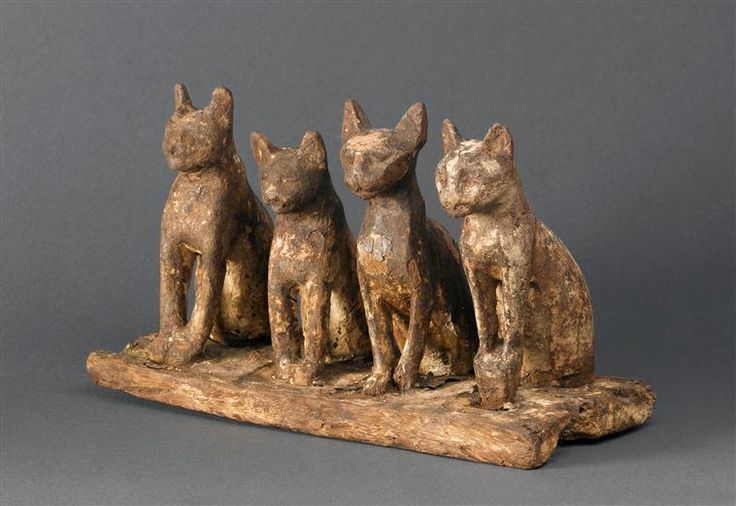Bastet, also known as Bast, was an ancient Egyptian goddess who originally had the role of protecting the Pharaohs. The inhabitants of the lower Nile depicted Bastet as a savage, lion-headed deity. After 1000 BCE, the Egyptians altered her image to the body of a woman and the head of a domesticated cat. Along with her change in appearance, she was also transformed into a peaceful and approachable deity. Instead of Bastet protecting Pharaohs, she was now a nurturer and protector of all households. Families soon began to invite cats inside their homes, thinking that they brought with them the spirit of Bastet. They worshiped these cats because they also hunted mice, snakes, and other pests that ruined their crops and their perishable goods. Bastet’s role as a goddess was further altered when she acquired the trait of fertility. Women would purchase pendants with Bastet and multiple kittens to enhance their fertility.1

Statues and depictions of Bastet vary. She transforms from a beast with a female lion’s head, to a woman with the head of a cat, to a regular black cat with kittens who sometimes held a rattle. Some thought the rattle was actually a musical instrument called a sistrum. Because of this, Bastet was also associated with music and dance. Soon after the sistrum was added to Bastet’s image, the Egyptians used the instrument at festivals where they would worship Bastet. Then, Bastet was depicted wearing a decorative dress, carrying the sistrum in her right hand and a shield in her left, with a bag over her arm.2
The Egyptians had an explanation for why she was transformed from a savage beast to a fertility and music goddess. Bastet was the daughter of Ra, the sun god who was vengeful. From him she got her aggressiveness. Her mother is unknown, but the Egyptians suspect that Ra sent young Bastet to Nubia as a lioness in isolation. There she was able to let out her rage, and then wander back to Egypt as a docile cat. Later an unknown king proclaimed that Bastet was his mother. Egyptian women then believed worshiping her would provide them with many children, as house cats would typically have up to twelve kittens; and one of her sons became king. Experts believe that the baby rattle was mistakenly interpreted as a sistrum, which led to her being known as a music and dance goddess.3

In depictions of wars on the walls of palaces, she was portrayed as a lion, and in homes she was a cat. Although Bastet was a goddess with many traits, that was not all that uncommon. In ancient Egypt gods and goddesses often served more than one purpose. Along with her most common traits, she was also thought of as the goddess of the sun, which she inherited from her father, as well as the goddess of physical pleasure. It was even believed that if a cat ran through a fire, the fire would be put out; therefore, she became the deity of firefighters.4
It is undeniable that Bastet was highly respected. Experts are still unable to determine when Egyptians first began to worship her as well as when her presence faded. Many statues of Bastet and mummified cats have been discovered along the lower Nile, which has led experts to believe that festivals were held there in her honor and locals worshiped her to the highest degree. Although she did have many roles, she is best known as the goddess of protection.5
“His totem animal in black onyx
erect on her haunches poised and aware
he brings in a dream that I might learn
cats are cats and gods—slit-eyed in the sun
in darkness with dilated iris she sees
protector I hope though at times in the night
I tense at her wild amorous cry…”
–Bastet 6
- The Salem Press Encyclopedia, 2o16, s.v. “Bastet (diety),” by Latha Iyer. ↵
- Kathryn Razavi, “The Lioness and the Kittycat: Egypt’s Great Feline Goddess” (Undergraduate Honors Thesis, University of Colorado, 2013), 20-25. ↵
- Nora Scott, “The Cat of Bastet,” The Metropolitan Museum of Art Bulletin, 1 (1958): 1. ↵
- Kathryn Razavi, “The Lioness and the Kittycat: Egypt’s Great Feline Goddess” (Undergraduate Honors Thesis, University of Colorado, 2013), 23. ↵
- Salem Press Encyclopedia, 2o16, s.v. “Bastet (diety),” by Latha Iyer. ↵
- Phyllis Stowell, “Bastet,” Psychological Perspectives 56, no. 3 (2013): 362-364. ↵



67 comments
Samman Tyata
I did not have much knowledge of any Egyptian gods or goddesses but article has helped me a lot to know more about them. Simply put, I really liked the way how you have managed your article in an effective and efficient manner. It was interesting to read that Bastet transforms from a beast with a female lion’s head, to a woman with the head of a cat, to a regular black cat with kittens who sometimes held a rattle. Great job!
Andrea Chavez
This is a very interesting topic. I always wondered why the Egyptians worshipped cats. If not for this article I would always think it was because they just liked them. I really like the way they portray her as fierce as a lion and the same time as docile as a cat. It kind of portrays how I like to see woman, fierce as a lion and when they want all nice like a cat.
Rafael Azuaje
This was one of the best articles I have read here. I can see how cats would be thought of as god-like. They have a real mysterious aura around them. When they move they are almost completely silent. It also makes me think of other Egyptian deities. It makes me think of the Egyptian goddess Sekhmet. There have been more that six hundred statues of the goddess Sekhmet found in Egypt. Fascinating.
Belene Cuellar
I’ve read some articles of Bastet and the evolution of her image, but I never quite understood the purpose of her change. I like how the author went in order of how she changed and then explained in detail of how her image appealed to those who worshiped her. It’s quite interesting to see how people go to such lengths to please these gods in order to gain something in their lives. Also the way cats were depicted as royalty and good luck is really interesting and at the same time actually makes sense.
Edward Cerna
I did not have much knowledge of any Egyptian gods or goddesses but reading this gave me knowledge of one. It seems that the people changed Bastets image to what they wanted it to be. They made her more approachable, changed her from the protector of pharaohs to the protector of all people, Made her a symbol of fertility and other things that you had mentioned. Overall I think this article was really informative and glad I came across it.
Tara Sellers
I knew Bastet was an Egyptian goddess that had something to do with cats. However, I did not know she was the goddess of protection. This article explains why cats where treated like gods in Egypt. The Egyptians would let cats into there homes because Bastet was the protector of households. Over the centuries little parts of who she was and what she looked like changed.
Marissa Gonzalez
I really enjoyed reading this article! Bastet, being an Egyptian Goddess was portrayed as a cat which I found unusual. It was interesting how people would welcome cats into their homes since they believed it brought the spirit of Bastet. Knowing that people would worship cats seemed very weird; however, this is what they believed in. I was never familiar with this Egyptian Goddess and I liked how well this article informed me. Great research and well done!
Faisal Alqarni
Hello Jennifer, before reading your article I had seen various pictures of cats in Egyptian ancient culture but I did not know what they meant. Now I know it was a god known as Baste. I love your use of imagery as your story flows it gives me a perspective of what am reading. I really was fascinated by the changing roles of this very fluid goddess and her acceptance by both the average and noble people of Egypt.
Samuel Sanchez
Interesting article never knew that much on the reasoning why the Egyptians would admired cats but after reading this article it makes a lot of sense. I never even heard of Bastet I only knew about Ra. Learning how this Goddess was interpreted for protecting the Pharaohs but eventually altered in protecting the household. I’m allergic to cats so I would not do so well in having cats in my household. Great article keep up the great work.
Lianna Ybarra
Very interesting article!! I had seen the last two images of the Bastet before and I thought it was two different symbols so I liked how this explained how this came to be. I wonder if this is why so many people love having cats and are so welcoming to them when they find them roaming around their homes. Maybe it’s an instinct they get that the Egyptians used to get as a symbol of something.